Difference between revisions of "Getting Started with OnePager Express Version 6.1 Add-in"
(→Displaying Data-Driven Task Links) |
|||
| (9 intermediate revisions by the same user not shown) | |||
| Line 1: | Line 1: | ||
| − | + | ==Overview== | |
| − | As with the previous version of OnePager Express, version 6.1 of '''OPX''' can be launched from a '''Desktop''' icon as well as from within Microsoft Excel ('''Add-in'''). | + | 1) As with the previous version of OnePager Express, version 6.1 of '''OPX''' can be launched from a '''Desktop''' icon as well as from within Microsoft Excel ('''Add-in'''). |
| − | + | 2) Please note that after selecting the '''Add-in''' launch option that you are not able to launch the OnePager '''Desktop''' application. | |
| − | + | 3) Only one of these applications ('''Add-in''' or '''Desktop''') can be active at a time. | |
| − | + | 4) If you attempt to launch both, a warning message appears as shown for '''OPX''' below.''' | |
<center>[[File:X53-3_0_3-53-(01)-11222015.png]]</center> | <center>[[File:X53-3_0_3-53-(01)-11222015.png]]</center> | ||
| − | + | 5) Further note that as mentioned in [[What's New with OnePager Release 6.1?]] <!--0.4-61-->, this new version has enhanced features such as '''Task Link Upgrades''' and '''Time Axis Upgrades''' to name a few. | |
| − | + | 7) This article covers the '''Getting Started''' process when you launch '''OPX''' from Microsoft Excel. | |
| − | + | 7) The article which provides '''Getting Started''' guidance when using the '''Desktop''' icon to launch '''OPX''' is at [[Getting Started with OnePager Express Version 6.1 Desktop | Getting Started with OnePager Express Desktop]]. <!--3.0.2.2-61.--> | |
| − | + | ==Launching OnePager Express for the First Time== | |
1) The '''OPX Add-in''' automatically displays the '''OnePager''' icon on the Microsoft Excel ribbon once OnePager is installed. That tool bar looks like this: | 1) The '''OPX Add-in''' automatically displays the '''OnePager''' icon on the Microsoft Excel ribbon once OnePager is installed. That tool bar looks like this: | ||
| Line 25: | Line 25: | ||
2) Clicking the '''OnePager Express…''' button takes you to the Project View Editor ('''PVE'''). Clicking the '''Templates…''' button lets you edit the '''Templates''' for your graphs. For now, it is simplest to use the default '''Template'''. You can learn how '''Templates''' let you customize and standardize graph features later in this document. | 2) Clicking the '''OnePager Express…''' button takes you to the Project View Editor ('''PVE'''). Clicking the '''Templates…''' button lets you edit the '''Templates''' for your graphs. For now, it is simplest to use the default '''Template'''. You can learn how '''Templates''' let you customize and standardize graph features later in this document. | ||
| − | 3) Before you launch '''OPX''', however, you must have certain scheduling fields in your Microsoft Excel | + | 3) Before you launch '''OPX''', however, you must have certain scheduling fields in your Microsoft Excel '''source plan'''. There is a lot of flexibility in how these fields can be named. A typical example is shown below. The only mandatory fields are fields representing '''Start''', '''Finish''', and '''Name'''. In this example, however, we are also including three optional fields: |
:a) A category field ('''Category''') used to assign '''colors''' to tasks. | :a) A category field ('''Category''') used to assign '''colors''' to tasks. | ||
| Line 34: | Line 34: | ||
<center>[[File:X61-3_0_3-61-(2)-10242017.png]]</center> | <center>[[File:X61-3_0_3-61-(2)-10242017.png]]</center> | ||
| − | <center>X61-3_0_3-61-(2)-10242017.png</center> | + | <!--center>X61-3_0_3-61-(2)-10242017.png</center--> |
| − | 4) To control which tasks get graphed, you must specify a '''flag''' field (e.g. Show It) that you wish to use. '''Numeric''' fields | + | 4) To control which tasks get graphed, you must specify a '''flag''' field (e.g. Show It) that you wish to use. '''Numeric''' fields can also be used the same as the text fields where a '''1''' in a '''Number''' field indicates '''Yes''' and a '''0''' in a '''Number''' field indicates '''No'''. See how this is done in the illustration above. |
:a) When making your first project view, we strongly recommend that you mark 50 or fewer tasks with '''Yes'''. | :a) When making your first project view, we strongly recommend that you mark 50 or fewer tasks with '''Yes'''. | ||
| Line 44: | Line 44: | ||
5) The following table describes field-heading types that '''OPX''' uses and shows variations on the heading titles that OnePager recognizes. | 5) The following table describes field-heading types that '''OPX''' uses and shows variations on the heading titles that OnePager recognizes. | ||
| − | :a) It is not mandatory that you used these field names, since '''OPX''' gives you a chance to choose the actual Microsoft Excel '''source plan''' fields that it | + | :a) It is not mandatory that you used these field names, since '''OPX''' gives you a chance to choose the actual Microsoft Excel '''source plan''' fields that it employs. However, using these names speeds things up because it helps '''OPX''' make reasonable guesses on which fields to use as its default selections. |
:b) Note that it shows that three of the field heading types must always be present: '''Name''', '''Start''', and '''Finish'''. | :b) Note that it shows that three of the field heading types must always be present: '''Name''', '''Start''', and '''Finish'''. | ||
| Line 55: | Line 55: | ||
<center>[[File:X61-3_0_3-60-(4)-10242017.png]]</center> | <center>[[File:X61-3_0_3-60-(4)-10242017.png]]</center> | ||
| − | <center>X61-3_0_3-60-(4)-10242017.png</center> | + | <!--center>X61-3_0_3-60-(4)-10242017.png</center--> |
7) The '''OnePager Express Start''' form provides you with three options: | 7) The '''OnePager Express Start''' form provides you with three options: | ||
| Line 65: | Line 65: | ||
:c) '''OPEN''' Clicking the '''OPEN''' button allows you to '''BROWSE FILES''' for an existing project view or select a recently-opened project view. Once selected and opened, the project view is available for editing. | :c) '''OPEN''' Clicking the '''OPEN''' button allows you to '''BROWSE FILES''' for an existing project view or select a recently-opened project view. Once selected and opened, the project view is available for editing. | ||
| − | + | ==Creating a New Project View== | |
| − | + | 1) Clicking the '''NEW''' button brings up the '''OPC''' form as shown below: | |
<center>[[File:X61-3_0_2_1-61-(5)-5022018.png]]</center> | <center>[[File:X61-3_0_2_1-61-(5)-5022018.png]]</center> | ||
| − | <center>X61-3_0_2_1-61-(5)-5022018.png</center> | + | <!--center>X61-3_0_2_1-61-(5)-5022018.png</center--> |
===Options on the New OnePager Choices form=== | ===Options on the New OnePager Choices form=== | ||
| − | + | 2) We’ve enhanced the '''OPC''' form to give you more options for selecting '''source files'''. The illustration above shows that '''OPX''' was initiated from Microsoft Excel with the '''source plan''' shown in the '''Selected File(s)''' group shown above. The '''Add/Remove''' button gives you the capability to '''add''' more '''source plans''' to the '''source packet''' or, for multiple file packets, to '''remove''' files. | |
:a) Clicking the '''Add/Remove''' button brings up the '''Data source selection''' form as shown below: | :a) Clicking the '''Add/Remove''' button brings up the '''Data source selection''' form as shown below: | ||
<center>[[File:X61-3_0_2_1-61-(6)-5022018.png]]</center> | <center>[[File:X61-3_0_2_1-61-(6)-5022018.png]]</center> | ||
| − | <center>X61-3_0_2_1-61-(6)-5022018.png</center> | + | <!--center>X61-3_0_2_1-61-(6)-5022018.png</center--> |
:b) The '''Data source selection''' form displays the current '''source plan''' that was loaded with Microsoft Excel when you clicked the '''OnePager Express...''' button. This form lets you '''Add''' more source Microsoft Excel '''source plans''' to create a multi-project project view or '''Remove''' a '''source plan''' from a multi-file '''source packet'''. These options are detailed below. | :b) The '''Data source selection''' form displays the current '''source plan''' that was loaded with Microsoft Excel when you clicked the '''OnePager Express...''' button. This form lets you '''Add''' more source Microsoft Excel '''source plans''' to create a multi-project project view or '''Remove''' a '''source plan''' from a multi-file '''source packet'''. These options are detailed below. | ||
| Line 88: | Line 88: | ||
<center>[[File:X61-3_0_2_1-61-(7)-5022018.png]]</center> | <center>[[File:X61-3_0_2_1-61-(7)-5022018.png]]</center> | ||
| − | <center>X61-3_0_2_1-61-(7)-5022018.png</center> | + | <!--center>X61-3_0_2_1-61-(7)-5022018.png</center--> |
| − | ::i) Clicking the '''BROWSE FILES…''' option displays a Window’s '''Open''' from which you | + | ::i) Clicking the '''BROWSE FILES…''' option displays a Window’s '''Open''' from which you can select a Microsoft Excel '''source plan''' to add to the '''source packet'''. A sample '''Open''' form is shown below: |
<center>[[File:X61-3_0_2_1-61-(8)-5022018.png]]</center> | <center>[[File:X61-3_0_2_1-61-(8)-5022018.png]]</center> | ||
| − | <center>X61-3_0_2_1-61-(8)-5022018.png</center> | + | <!--center>X61-3_0_2_1-61-(8)-5022018.png</center--> |
::ii) When you select a desired Microsoft Excel '''source plan''' and click the '''Open''' button as shown above, '''OPX''' adds the '''source plan''' to the '''source packet''' and displays it in the '''Data source selection''' window as shown below: | ::ii) When you select a desired Microsoft Excel '''source plan''' and click the '''Open''' button as shown above, '''OPX''' adds the '''source plan''' to the '''source packet''' and displays it in the '''Data source selection''' window as shown below: | ||
<center>[[File:X61-3_0_2_1-61-(9)-5022018.png]]</center> | <center>[[File:X61-3_0_2_1-61-(9)-5022018.png]]</center> | ||
| − | <center>X61-3_0_2_1-61-(9)-5022018.png</center> | + | <!--center>X61-3_0_2_1-61-(9)-5022018.png</center--> |
::iii) The selected '''source plan''' is added to the '''source packet''' as shown above. '''OPX''' shows the path name of the '''source plan''' in the window if you hover the mouse over the '''source plan''' name. | ::iii) The selected '''source plan''' is added to the '''source packet''' as shown above. '''OPX''' shows the path name of the '''source plan''' in the window if you hover the mouse over the '''source plan''' name. | ||
| − | ::iv) If you select a recently used '''source plan''' from the dropdown menu displayed with the '''Add''' button is clicked in the '''Data source selection''' form, '''OPX''' | + | ::iv) If you select a recently used '''source plan''' from the dropdown menu displayed with the '''Add''' button is clicked in the '''Data source selection''' form, '''OPX''' adds that '''source plan''' to the '''source packet'''. |
===Removing a Source Plan=== | ===Removing a Source Plan=== | ||
| Line 109: | Line 109: | ||
<center>[[File:X61-3_0_2_1-61-(10)-5022018.png]]</center> | <center>[[File:X61-3_0_2_1-61-(10)-5022018.png]]</center> | ||
| − | <center>X61-3_0_2_1-61-(10)-5022018.png</center> | + | <!--center>X61-3_0_2_1-61-(10)-5022018.png</center--> |
<center>[[File:X61-3_0_2_1-61-(11)-5022018.png]]</center> | <center>[[File:X61-3_0_2_1-61-(11)-5022018.png]]</center> | ||
| − | <center>X61-3_0_2_1-61-(11)-5022018.png</center> | + | <!--center>X61-3_0_2_1-61-(11)-5022018.png</center--> |
===Other Choices to Make=== | ===Other Choices to Make=== | ||
| − | + | 3) Moving on to the other groups of the '''OPC''' form, you are asked to confirm a few things before you build the project view. It makes good guesses for each of these choices, but you can change any of them: | |
<center>[[File:X61-3_0_2_1-61-(15)-5022018.png]]</center> | <center>[[File:X61-3_0_2_1-61-(15)-5022018.png]]</center> | ||
| − | <center>X61-3_0_2_1-61-(15)-5022018.png</center> | + | <!--center>X61-3_0_2_1-61-(15)-5022018.png</center--> |
:a) '''Starting Template''': The current '''Template''' determines which columns get imported from Microsoft Excel and how the initial project view looks. '''OPX''' ships with many sample '''Templates''', but you can also customize your own '''Templates'''. | :a) '''Starting Template''': The current '''Template''' determines which columns get imported from Microsoft Excel and how the initial project view looks. '''OPX''' ships with many sample '''Templates''', but you can also customize your own '''Templates'''. | ||
| Line 127: | Line 127: | ||
::ii) For now, just stick with the default '''Template''' entitled '''Single Project Gantt View – Detailed''', but you can always use a different '''Template''' to get a different type of project view. | ::ii) For now, just stick with the default '''Template''' entitled '''Single Project Gantt View – Detailed''', but you can always use a different '''Template''' to get a different type of project view. | ||
| − | :b) '''Title of the New Project View''': This is the '''Title''' of the graph and also the suggested '''source plan''' name in which it | + | :b) '''Title of the New Project View''': This is the '''Title''' of the graph and also the suggested '''source plan''' name in which it is saved. You can change the '''source plan''' name when you save it. We recommend that you enter a '''Title''' that helps you identify the view later on. |
::i) For each project view that you create, OnePager remembers '''colors, titles, legends, font sizes''', and all other graph '''properties''' so that your work is saved for future use. | ::i) For each project view that you create, OnePager remembers '''colors, titles, legends, font sizes''', and all other graph '''properties''' so that your work is saved for future use. | ||
| Line 135: | Line 135: | ||
:c) '''Task Selection''': This is how you tell '''OPX''' which tasks from your Microsoft Excel '''source plan''' to include. | :c) '''Task Selection''': This is how you tell '''OPX''' which tasks from your Microsoft Excel '''source plan''' to include. | ||
| − | :::i) Either click the '''Select all tasks''' radio button to graph everything or choose a '''flag''' field. You can make several project views from a single Microsoft Excel '''source plan''', each using a different '''flag''' or '''number''' field. In '''OPX''' if no '''flags''' are set to '''Yes''', '''OPX''' | + | :::i) Either click the '''Select all tasks''' radio button to graph everything or choose a '''flag''' field. You can make several project views from a single Microsoft Excel '''source plan''', each using a different '''flag''' or '''number''' field. In '''OPX''' if no '''flags''' are set to '''Yes''', '''OPX''' provides the user with a warning message. |
| − | :::ii) Clicking the '''Select tasks by custom filter''' button activates the '''Edit filters...''' button. Clicking the '''Edit filters...''' button takes you to a form that controls the new '''Conditional Import Filters''' feature. Please see the article titled [[Conditional Import for Version 6.0 (Portal) | Conditional Import Filters (Portal)]] 7.18.1-61 for more detailed on the use of this new feature. | + | :::ii) Clicking the '''Select tasks by custom filter''' button activates the '''Edit filters...''' button. Clicking the '''Edit filters...''' button takes you to a form that controls the new '''Conditional Import Filters''' feature. Please see the article titled [[Conditional Import for Version 6.0 (Portal) | Conditional Import Filters (Portal)]] <!--7.18.1-61--> for more detailed on the use of this new feature. |
:d) '''Snapshot Date''': This is the date of the report and lets you keep track of how schedules change over time. Each project view can have many snapshots. | :d) '''Snapshot Date''': This is the date of the report and lets you keep track of how schedules change over time. Each project view can have many snapshots. | ||
| − | + | 4) The '''Show field mappings''' checkbox near the bottom of the form can be checked in the '''OPC''' form and gives a chance to review and change the Microsoft Excel '''field mappings''' to '''OPX''' before you make your first project view. To do this, click the '''Next>''' button. You see the following screen: | |
<center>[[File:X60-3_0_3-60-(15AA)-03072017.png]]</center> | <center>[[File:X60-3_0_3-60-(15AA)-03072017.png]]</center> | ||
| − | <center>X60-3_0_3-60-(15AA)-03072017.png</center> | + | <!--center>X60-3_0_3-60-(15AA)-03072017.png</center--> |
| − | + | 5) Notice in the graphic above that '''OPX''' has relied on the current '''Template''' to make some guesses on what Microsoft Excel fields should be used in making the graph. You can easily change any of these '''field mappings''' by making selections from the dropdown menus. For example, we show below how to change the '''Finish Date''': | |
<center>[[File:X61-3_0_3-61-(16AA)-10242017.png]]</center> | <center>[[File:X61-3_0_3-61-(16AA)-10242017.png]]</center> | ||
| − | <center>X61-3_0_3-61-(16AA)-10242017.png</center> | + | <!--center>X61-3_0_3-61-(16AA)-10242017.png</center--> |
===Making the Graph=== | ===Making the Graph=== | ||
| − | + | 6) Once you are satisfied with the '''field mappings''', click on '''Create new project view''' button to import your selected data and create a project view. After a few second you see a screen that looks like this: | |
<center>[[File:X61-3_0_2_1-61-(17-1)-5022018.png]]</center> | <center>[[File:X61-3_0_2_1-61-(17-1)-5022018.png]]</center> | ||
| − | <center>X61-3_0_2_1-61-(17-1)-5022018.png</center> | + | <!--center>X61-3_0_2_1-61-(17-1)-5022018.png</center--> |
| − | + | 7) Note that each task or milestone was '''color''' coded based on the value in the '''Category''' field. | |
:a) The '''Legend''' contains an optional diagram near the bottom, explaining that the bars inside the Gantt bars represent percent complete extracted from Microsoft Excel. | :a) The '''Legend''' contains an optional diagram near the bottom, explaining that the bars inside the Gantt bars represent percent complete extracted from Microsoft Excel. | ||
| Line 166: | Line 166: | ||
<center>[[File:X61-3_0_2_1-61-(18)-5022018.png]]</center> | <center>[[File:X61-3_0_2_1-61-(18)-5022018.png]]</center> | ||
| − | <center>X61-3_0_2_1-61-(18)-5022018.png</center> | + | <!--center>X61-3_0_2_1-61-(18)-5022018.png</center--> |
===Opening a Project View=== | ===Opening a Project View=== | ||
| − | + | 8) The right-most button on the '''OPC''' form is the '''OPEN''' button. Clicking the '''OPEN''' button displays a dropdown menu which happens to be the same for the '''NEW''' and '''UPDATE''' buttons. The options in the dropdown are discussed below: | |
<center>[[File:X61-3_0_2_1-61-(18A)-5022018.png]]</center> | <center>[[File:X61-3_0_2_1-61-(18A)-5022018.png]]</center> | ||
| − | <center>X61-3_0_2_1-61-(18A)-5022018.png</center> | + | <!--center>X61-3_0_2_1-61-(18A)-5022018.png</center--> |
| − | :a) Clicking the '''BROWSE FILES...''' option brings up a Windows '''Open''' form from which you can select a '''.TAM''' that you want to open. Selecting the desired '''.TAM''' causes '''OPX''' to display the selected project view. From this position, you | + | :a) Clicking the '''BROWSE FILES...''' option brings up a Windows '''Open''' form from which you can select a '''.TAM''' that you want to open. Selecting the desired '''.TAM''' causes '''OPX''' to display the selected project view. From this position, you can edit the project view, save it, or share it with others. |
:b) Clicking any of the '''RECENT project view ''' items the dropdown menu above causes '''OPX''' to load the associated '''.TAM''' into the '''PVE''' where you can edit the project view, save it, or share it with others. | :b) Clicking any of the '''RECENT project view ''' items the dropdown menu above causes '''OPX''' to load the associated '''.TAM''' into the '''PVE''' where you can edit the project view, save it, or share it with others. | ||
| Line 181: | Line 181: | ||
===Updating a Project View with Changes Made to the Microsoft Excel Source Plan Data=== | ===Updating a Project View with Changes Made to the Microsoft Excel Source Plan Data=== | ||
| − | + | 9) Suppose after examining the project view you created before you realize that it is best to show more task bars. This, you think, greatly improve the schedule discussion you are about to present Updating the project view at this point is a simple matter. Recall that '''OPX''' is active and the '''PVE''' is displaying the current project view you want to update. Additionally, the Microsoft Excel '''source plan''' and the application are active. The original project view looked like this: | |
<center>[[File:X61-3_0_2_1-61-(18B)-5022018.png]]</center> | <center>[[File:X61-3_0_2_1-61-(18B)-5022018.png]]</center> | ||
| − | <center>X61-3_0_2_1-61-(18B)-5022018.png</center> | + | <!--center>X61-3_0_2_1-61-(18B)-5022018.png</center--> |
:a) Since Microsoft Excel is still an active program and the Microsoft Excel '''source plan''' you are using is still being displayed, go back to the Microsoft Excel application and change the '''Show It''' field setting for the rows you want to now display from '''No''' to '''Yes'''. As section of the Microsoft Excel '''source plan''' where this is done is shown below: | :a) Since Microsoft Excel is still an active program and the Microsoft Excel '''source plan''' you are using is still being displayed, go back to the Microsoft Excel application and change the '''Show It''' field setting for the rows you want to now display from '''No''' to '''Yes'''. As section of the Microsoft Excel '''source plan''' where this is done is shown below: | ||
<center>[[File:X61-3_0_2_1-61-(18C)-5022018.png]]</center> | <center>[[File:X61-3_0_2_1-61-(18C)-5022018.png]]</center> | ||
| − | <center>X61-3_0_2_1-61-(18C)-5022018.png</center> | + | <!--center>X61-3_0_2_1-61-(18C)-5022018.png</center--> |
:b) Once you’ve made the '''Show It''' field changes lines 7 through 15 in the Microsoft Excel the '''source plan''' looks like this: | :b) Once you’ve made the '''Show It''' field changes lines 7 through 15 in the Microsoft Excel the '''source plan''' looks like this: | ||
<center>[[File:X61-3_0_2_1-61-(18D)-5022018.png]]</center> | <center>[[File:X61-3_0_2_1-61-(18D)-5022018.png]]</center> | ||
| − | <center>X61-3_0_2_1-61-(18D)-5022018.png</center> | + | <!--center>X61-3_0_2_1-61-(18D)-5022018.png</center--> |
:c) With the Microsoft Excel '''source plan''' updated, go back to '''OPX''' and navigate to the '''Data''' tab on the ribbon where there are several buttons. To update your project view to now show the additional rows from your Microsoft Excel '''source plan''' click the '''Replace Snapshot''' button as shown below: | :c) With the Microsoft Excel '''source plan''' updated, go back to '''OPX''' and navigate to the '''Data''' tab on the ribbon where there are several buttons. To update your project view to now show the additional rows from your Microsoft Excel '''source plan''' click the '''Replace Snapshot''' button as shown below: | ||
<center>[[File:X60-3_0_3-60-(17C)-01272017.png]]</center> | <center>[[File:X60-3_0_3-60-(17C)-01272017.png]]</center> | ||
| − | <center>X60-3_0_3-60-(17C)-01272017.png</center> | + | <!--center>X60-3_0_3-60-(17C)-01272017.png</center--> |
:d) When you click the '''Replace Snapshot''' button, '''OPX''' goes back to the associated Microsoft Excel '''source plan''' that you just changed, bring in all the rows that changed, and update your project view. | :d) When you click the '''Replace Snapshot''' button, '''OPX''' goes back to the associated Microsoft Excel '''source plan''' that you just changed, bring in all the rows that changed, and update your project view. | ||
| Line 206: | Line 206: | ||
<center>[[File:X61-3_0_2_1-61-(18E)-5022018.png]]</center> | <center>[[File:X61-3_0_2_1-61-(18E)-5022018.png]]</center> | ||
| − | <center>X61-3_0_2_1-61-(18E)-5022018.png</center> | + | <!--center>X61-3_0_2_1-61-(18E)-5022018.png</center--> |
| − | + | 10) The example above is just one of many uses of the '''Data''' tab’s '''Replace Snapshot''' button when you need to update a project view. And, you can do this as many times as necessary until the project view is the way you need it. In addition to adding and removing rows by changing the '''Show It''' field, you can change '''Start Dates''', '''Finish Dates''', or '''Resource Names'''' and display these data changes in the project view. Using the procedure above you can do this very efficiently. | |
| − | + | 11) You can now save the project view by giving it a name. When you save the project view in '''OPX''', OnePager saves the '''.TAM''' and saves the Microsoft Excel '''source plan name''' and '''path''' information. This is useful when you want to further update the project view or when you want to add a snapshot later on. In the examples below it is assumes that the project view is saved as '''BlueGrass Project Report - Express'''. | |
===Adding a Snapshot to a Project View=== | ===Adding a Snapshot to a Project View=== | ||
| − | + | 12) The power of '''OPX''' is illustrated when, after a period of progress on the project, it is time to produce another project view. OnePager produces your next snapshot with the same look and feel as the original. Assuming that the Microsoft Excel '''source plan''' was updated with actual start and '''finish''', '''percent complete''', and other relevant data during the reporting interval, '''OPX''' can easily generate a new snapshot. | |
| − | + | 13) Suppose we have the following project view created on 11/1/2018 and we want to create another graph from the updated Microsoft Project '''source plan''' on 12/1/2018. | |
<center>[[File:X61-3_0_2_1-61-(18F)-5022018.png]]</center> | <center>[[File:X61-3_0_2_1-61-(18F)-5022018.png]]</center> | ||
| − | <center>X61-3_0_2_1-61-(18F)-5022018.png</center> | + | <!--center>X61-3_0_2_1-61-(18F)-5022018.png</center--> |
:a) Before creating a new snapshot for 12/1/2018 as planned, we need to update the Microsoft Excel '''source plan''' say by updating the '''Percent Complete''' for the following tasks to the percentage indicated: | :a) Before creating a new snapshot for 12/1/2018 as planned, we need to update the Microsoft Excel '''source plan''' say by updating the '''Percent Complete''' for the following tasks to the percentage indicated: | ||
| Line 233: | Line 233: | ||
<center>[[File:X61-3_0_2_1-61-(18G)-5022018.png]]</center> | <center>[[File:X61-3_0_2_1-61-(18G)-5022018.png]]</center> | ||
| − | <center>X61-3_0_2_1-61-(18G)-5022018.png</center> | + | <!--center>X61-3_0_2_1-61-(18G)-5022018.png</center--> |
| − | :d) In the '''OPC''' form above we selected the '''NEW snapshot at date:''' as shown. You | + | :d) In the '''OPC''' form above we selected the '''NEW snapshot at date:''' as shown. You can want to select a current date for the snapshot so that this snapshot represents the project at the status date point in time. To see which snapshot dates already exist, just position your mouse over the '''NEW snapshot-date:''' window to see a list of the existing dates. |
<center>[[File:X61-3_0_2_1-61-(18H)-5022018.png]]</center> | <center>[[File:X61-3_0_2_1-61-(18H)-5022018.png]]</center> | ||
| − | <center>X61-3_0_2_1-61-(18H)-5022018.png</center> | + | <!--center>X61-3_0_2_1-61-(18H)-5022018.png</center--> |
:e) Use the built in calendar dropdown or type in the new snapshot’s month, day, and year in the window provided as shown below: | :e) Use the built in calendar dropdown or type in the new snapshot’s month, day, and year in the window provided as shown below: | ||
<center>[[File:X61-3_0_2_1-61-(18I)-5022018.png]]</center> | <center>[[File:X61-3_0_2_1-61-(18I)-5022018.png]]</center> | ||
| − | <center>X61-3_0_2_1-61-(18I)-5022018.png</center> | + | <!--center>X61-3_0_2_1-61-(18I)-5022018.png</center--> |
:f) Uncheck the '''Show field mappings''' checkbox if you want to use the same '''field mappings''' as you used before. The bottom of the screen now looks like this: | :f) Uncheck the '''Show field mappings''' checkbox if you want to use the same '''field mappings''' as you used before. The bottom of the screen now looks like this: | ||
<center>[[File:P60-3_0_1-60-(26)-01252017.png]]</center> | <center>[[File:P60-3_0_1-60-(26)-01252017.png]]</center> | ||
| − | <center>P60-3_0_1-60-(26)-01252017.png</center> | + | <!--center>P60-3_0_1-60-(26)-01252017.png</center--> |
:g) Pressing the large '''New''' button creates a new snapshot for the project view. The project view opens at the new snapshot. The '''color''', '''fonts''', '''title''', and '''swimlane''' assignments are consistent between the two snapshots: | :g) Pressing the large '''New''' button creates a new snapshot for the project view. The project view opens at the new snapshot. The '''color''', '''fonts''', '''title''', and '''swimlane''' assignments are consistent between the two snapshots: | ||
<center>[[File:X61-3_0_2_1-61-(22)-5022018.png]]</center> | <center>[[File:X61-3_0_2_1-61-(22)-5022018.png]]</center> | ||
| − | <center>X61-3_0_2_1-61-(22)-5022018.png</center> | + | <!--center>X61-3_0_2_1-61-(22)-5022018.png</center--> |
:h) You can go back and forth between the two snapshots by using the '''snapshot forward/backward''' buttons on the '''View''' tab as shown below: | :h) You can go back and forth between the two snapshots by using the '''snapshot forward/backward''' buttons on the '''View''' tab as shown below: | ||
<center>[[File:X61-3_0_2_1-61-(23)-5022018.png]]</center> | <center>[[File:X61-3_0_2_1-61-(23)-5022018.png]]</center> | ||
| − | <center>X61-3_0_2_1-61-(23)-5022018.png</center> | + | <!--center>X61-3_0_2_1-61-(23)-5022018.png</center--> |
| − | + | ==Editing the Project View== | |
| − | + | 1) You can edit the '''font sizes''' and '''text positions''' to optimize readability. To do this, hold down the left mouse button and '''drag''' a selection box that encloses many tasks/milestones at once ('''Lasso'''): | |
<center>[[File:X61-3_0_2_1-61-(24)-5022018.png]]</center> | <center>[[File:X61-3_0_2_1-61-(24)-5022018.png]]</center> | ||
| − | <center>X61-3_0_2_1-61-(24)-5022018.png</center> | + | <!--center>X61-3_0_2_1-61-(24)-5022018.png</center--> |
:a) When you release the mouse, the enclosed tasks/milestones are all be selected: | :a) When you release the mouse, the enclosed tasks/milestones are all be selected: | ||
<center>[[File:X61-3_0_2_1-61-(25)-5022018.png]]</center> | <center>[[File:X61-3_0_2_1-61-(25)-5022018.png]]</center> | ||
| − | <center>X61-3_0_2_1-61-(25)-5022018.png</center> | + | <!--center>X61-3_0_2_1-61-(25)-5022018.png</center--> |
:b) Click on the '''Increase Font Size''' button on the tool bar shown below: | :b) Click on the '''Increase Font Size''' button on the tool bar shown below: | ||
<center>[[File:X61-3_0_2_1-61-(26)-5022018.png]]</center> | <center>[[File:X61-3_0_2_1-61-(26)-5022018.png]]</center> | ||
| − | <center>X61-3_0_2_1-61-(26)-5022018.png</center> | + | <!--center>X61-3_0_2_1-61-(26)-5022018.png</center--> |
:c) The project view now looks something like this: | :c) The project view now looks something like this: | ||
<center>[[File:X61-3_0_2_1-61-(27)-5022018.png]]</center> | <center>[[File:X61-3_0_2_1-61-(27)-5022018.png]]</center> | ||
| − | <center>X61-3_0_2_1-61-(27)-5022018.png</center> | + | <!--center>X61-3_0_2_1-61-(27)-5022018.png</center--> |
:d) Repeating this operation for the remaining tasks/milestones (we could have done '''Select All''' and done it all at once!), we obtain a project view with larger fonts on all the tasks/milestones: | :d) Repeating this operation for the remaining tasks/milestones (we could have done '''Select All''' and done it all at once!), we obtain a project view with larger fonts on all the tasks/milestones: | ||
<center>[[File:X61-3_0_2_1-61-(28)-5022018.png]]</center> | <center>[[File:X61-3_0_2_1-61-(28)-5022018.png]]</center> | ||
| − | <center>X61-3_0_2_1-61-(28)-5022018.png</center> | + | <!--center>X61-3_0_2_1-61-(28)-5022018.png</center--> |
| − | + | 2) Another common editing action is to move the task names from their current positions to a positions elsewhere around or on the task bar. | |
:a) To do this, select a set of tasks/milestones as before, but this time click one of the '''text-positioning''' buttons on the tool bar: | :a) To do this, select a set of tasks/milestones as before, but this time click one of the '''text-positioning''' buttons on the tool bar: | ||
<center>[[File:X61-3_0_2_1-61-(29)-5032018.png]]</center> | <center>[[File:X61-3_0_2_1-61-(29)-5032018.png]]</center> | ||
| − | <center>X61-3_0_2_1-61-(29)-5032018.png</center> | + | <!--center>X61-3_0_2_1-61-(29)-5032018.png</center--> |
:b) In case you change your mind about the last editing action you took, you can '''UNDO''' the last editing action by clicking the '''UNDO''' button above the OnePager tool bar. Successive clicking the '''UNDO''' button undoes editing actions in the reverse order that they were applied. | :b) In case you change your mind about the last editing action you took, you can '''UNDO''' the last editing action by clicking the '''UNDO''' button above the OnePager tool bar. Successive clicking the '''UNDO''' button undoes editing actions in the reverse order that they were applied. | ||
<center>[[File:X61-3_0_2_1-61-(31)-5032018.png]]</center> | <center>[[File:X61-3_0_2_1-61-(31)-5032018.png]]</center> | ||
| − | <center>X61-3_0_2_1-61-(31)-5032018.png</center> | + | <!--center>X61-3_0_2_1-61-(31)-5032018.png</center--> |
| − | + | 3) Save the edited project view by clicking the '''Save''' button above the tool bar next to the '''UNDO''' button. All of the '''font size''' changes, '''text-position''' edits, and the new '''Legend''' position are now saved in the file structure in case you need to update this project view with new data at a later time. | |
===Copying the Project View to PowerPoint=== | ===Copying the Project View to PowerPoint=== | ||
| − | + | 4) Finally copy the current snapshot of the project view to the clipboard by clicking the '''Copy''' button on the '''Home''' ribbon. Then paste the graph into a PowerPoint slide, as shown below: | |
<center>[[File:X61-3_0_2_1-61-(32)-5032018.png]]</center> | <center>[[File:X61-3_0_2_1-61-(32)-5032018.png]]</center> | ||
| − | <center>X61-3_0_2_1-61-(32)-5032018.png</center> | + | <!--center>X61-3_0_2_1-61-(32)-5032018.png</center--> |
| − | + | 5) That’s it! You have now created a professional 1-page schedule summary from a complex Microsoft Excel schedule and have copied it into a PowerPoint presentation. | |
:a) You can also print the graph by selecting the '''Print''' button on the '''File''' tab. | :a) You can also print the graph by selecting the '''Print''' button on the '''File''' tab. | ||
| Line 314: | Line 314: | ||
:b) OnePager has other features that let you move tasks vertically to different '''rows and swimlanes''', change the number of swimlanes, add swimlane titles, show dependencies among tasks, change task colors, hide tasks, add floating comment boxes, and standardize on graph styles across organizations. | :b) OnePager has other features that let you move tasks vertically to different '''rows and swimlanes''', change the number of swimlanes, add swimlane titles, show dependencies among tasks, change task colors, hide tasks, add floating comment boxes, and standardize on graph styles across organizations. | ||
| − | :c) To learn more about these features, read about the specific workflows in this Wiki at [[Basic Workflows for Version 6.1 (Portal) | Basic Workflows (Portal)]] 3.0.1-61 and [[Manual Editing for Version 6.1 (Portal) | Manual Editing]] 9.0.1-61. | + | :c) To learn more about these features, read about the specific workflows in this Wiki at [[Basic Workflows for Version 6.1 (Portal) | Basic Workflows (Portal)]] <!--3.0.1-61--> and [[Manual Editing for Version 6.1 (Portal) | Manual versus Data-Driven Editing (Portal)]]. <!--9.0.1-61.--> |
===Displaying Data-Driven Task Links=== | ===Displaying Data-Driven Task Links=== | ||
| − | + | 6) OnePager Express 6.1 is enhanced to assist you with displaying '''Task Link''' '''dependencies''' from data you provide in your Microsoft Excel '''source plan'''. Typically, this feature is turned '''OFF''' in all '''Templates''' distributed with OnePager. However, the feature can be turned '''ON''' either before or after the creation of a project view. | |
| − | :a) To turn the ''' | + | :a) To turn the '''Data-Driven Task Link''' feature '''ON''' prior to creating a project view, go to the '''Template''' form you plan to uses and click on the '''Task Links''' tab and then click the '''Import predecessors''' checkbox in the '''Data-Driven Task Links''' control group as shown below: |
<center>[[File:X61-3_0_2_1-61-(38)-05032018.png]]</center> | <center>[[File:X61-3_0_2_1-61-(38)-05032018.png]]</center> | ||
| − | <center>X61-3_0_2_1-61-(38)-05032018.png</center> | + | <!--center>X61-3_0_2_1-61-(38)-05032018.png</center--> |
:b) In the '''Template Task Link''' tab above there are two additional controls that need to be set to tell OnePager Express which data field you are using to express task '''dependencies''' in the form of '''predecessors''' and which '''dependency format''' you are using either (1) Microsoft Project or (2) Oracle Primavera. These controls are in the form of dropdown menus as shown for the '''dependency format''' selector below: | :b) In the '''Template Task Link''' tab above there are two additional controls that need to be set to tell OnePager Express which data field you are using to express task '''dependencies''' in the form of '''predecessors''' and which '''dependency format''' you are using either (1) Microsoft Project or (2) Oracle Primavera. These controls are in the form of dropdown menus as shown for the '''dependency format''' selector below: | ||
<center>[[File:X61-3_0_2_1-61-(38A)-05032018.png]]</center> | <center>[[File:X61-3_0_2_1-61-(38A)-05032018.png]]</center> | ||
| − | <center>X61-3_0_2_1-61-(38A)-05032018.png</center> | + | <!--center>X61-3_0_2_1-61-(38A)-05032018.png</center--> |
:c) With the '''Import predecessors''' checkbox checked and the '''dependency''' data field and '''dependency format''' selections made in the '''Template''' form, the project view first created looks like this: | :c) With the '''Import predecessors''' checkbox checked and the '''dependency''' data field and '''dependency format''' selections made in the '''Template''' form, the project view first created looks like this: | ||
<center>[[File:X61-3_0_2_1-61-(39)-05032018.png]]</center> | <center>[[File:X61-3_0_2_1-61-(39)-05032018.png]]</center> | ||
| − | <center>X61-3_0_2_1-61-(39)-05032018.png</center> | + | <!--center>X61-3_0_2_1-61-(39)-05032018.png</center--> |
| − | : | + | :d) To turn the '''Data-Driven Task Link''' feature '''ON''' after the project view is created, go to the '''Project-View Properties''' form's '''Task Links''' tab and then click the '''Import predecessors''' checkbox in the '''Data-Driven Task Links''' control group as shown below: |
| − | <center>[[File: | + | <center>[[File:X61-3_0_2_1-61-(40)-05032018.png]]</center> |
| − | <center> | + | <!--center>X61-3_0_2_1-61-(40)-05032018.png</center--> |
| − | : | + | :e) Once imported, '''Data-Driven Task Links''' can be '''shown''' or '''hidden''' and can be edited globally using the '''Template/Project-View Properties''' forms as shown above or individually using a selection right-click '''context menu'''. |
| − | : | + | :f) OnePager Express 6.1 continues to support manual '''Task Links''' which in previous OnePager Express versions were called '''Event Links'''. |
| − | + | 7) The OnePager version 6.1 '''Data-Driven Task Links''' feature is flexible and powerful. More details are provided in the series of articles at: [[Linking Task and Milestones Using Manual and Data-Driven Task Links for Version 6.1 | Linking Task and Milestone Using Manual and Data-Driven Task Links (Portal)]]. <!--19.0.1-61.--> | |
==Related Links== | ==Related Links== | ||
| − | [[What's New with OnePager Release 6.1?]] 0.4-61 | + | [[What's New with OnePager Release 6.1?]] <!--0.4-61--> |
| − | [[Getting Started with OnePager Express Version 6.1 Desktop | Getting Started with OnePager Express Desktop]] 3.0.2.2-61 | + | [[Getting Started with OnePager Express Version 6.1 Desktop | Getting Started with OnePager Express Desktop]] <!--3.0.2.2-61--> |
| − | [[Conditional Import for Version 6.1 (Portal) | Conditional Import Filters (Portal)]] 7.18.1-61 | + | [[Conditional Import for Version 6.1 (Portal) | Conditional Import Filters (Portal)]] <!--7.18.1-61--> |
| − | [[Basic Workflows for Version 6.1 (Portal) | Basic Workflows (Portal)]] 7.0.1-61 | + | [[Basic Workflows for Version 6.1 (Portal) | Basic Workflows (Portal)]] <!--7.0.1-61--> |
| − | [[Manual Editing for Version 6.1 (Portal) | Manual Editing]] 9.0.1-61 | + | [[Manual Editing for Version 6.1 (Portal) | Manual versus Data-Driven Editing (Portal)]] <!--9.0.1-61--> |
| + | |||
| + | [[Linking Task and Milestones Using Manual and Data-Driven Task Links for Version 6.1 | Linking Task and Milestone Using Manual and Data-Driven Task Links (Portal)]] <!--19.0.1-61--> | ||
(3.0.2.1-61) | (3.0.2.1-61) | ||
Latest revision as of 16:30, 18 December 2018
Contents
- 1 Overview
- 2 Launching OnePager Express for the First Time
- 3 Creating a New Project View
- 3.1 Options on the New OnePager Choices form
- 3.2 Adding a New Source Plan
- 3.3 Removing a Source Plan
- 3.4 Other Choices to Make
- 3.5 Making the Graph
- 3.6 Opening a Project View
- 3.7 Updating a Project View with Changes Made to the Microsoft Excel Source Plan Data
- 3.8 Adding a Snapshot to a Project View
- 4 Editing the Project View
- 5 Related Links
Overview
1) As with the previous version of OnePager Express, version 6.1 of OPX can be launched from a Desktop icon as well as from within Microsoft Excel (Add-in).
2) Please note that after selecting the Add-in launch option that you are not able to launch the OnePager Desktop application.
3) Only one of these applications (Add-in or Desktop) can be active at a time.
4) If you attempt to launch both, a warning message appears as shown for OPX below.
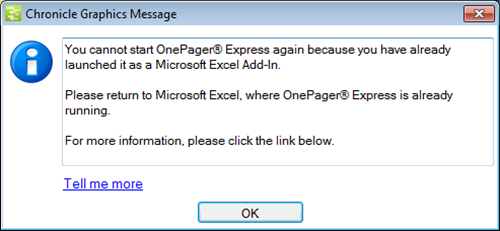
5) Further note that as mentioned in What's New with OnePager Release 6.1? , this new version has enhanced features such as Task Link Upgrades and Time Axis Upgrades to name a few.
7) This article covers the Getting Started process when you launch OPX from Microsoft Excel.
7) The article which provides Getting Started guidance when using the Desktop icon to launch OPX is at Getting Started with OnePager Express Desktop.
Launching OnePager Express for the First Time
1) The OPX Add-in automatically displays the OnePager icon on the Microsoft Excel ribbon once OnePager is installed. That tool bar looks like this:
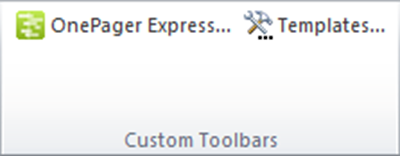
2) Clicking the OnePager Express… button takes you to the Project View Editor (PVE). Clicking the Templates… button lets you edit the Templates for your graphs. For now, it is simplest to use the default Template. You can learn how Templates let you customize and standardize graph features later in this document.
3) Before you launch OPX, however, you must have certain scheduling fields in your Microsoft Excel source plan. There is a lot of flexibility in how these fields can be named. A typical example is shown below. The only mandatory fields are fields representing Start, Finish, and Name. In this example, however, we are also including three optional fields:
- a) A category field (Category) used to assign colors to tasks.
- b) A selection field (Show It) use to choose which tasks to graph.
- c) A Task ID field that OnePager uses to keep track of tasks/milestones as your Microsoft Excel plan is change through additions or deletions over the course of the project.
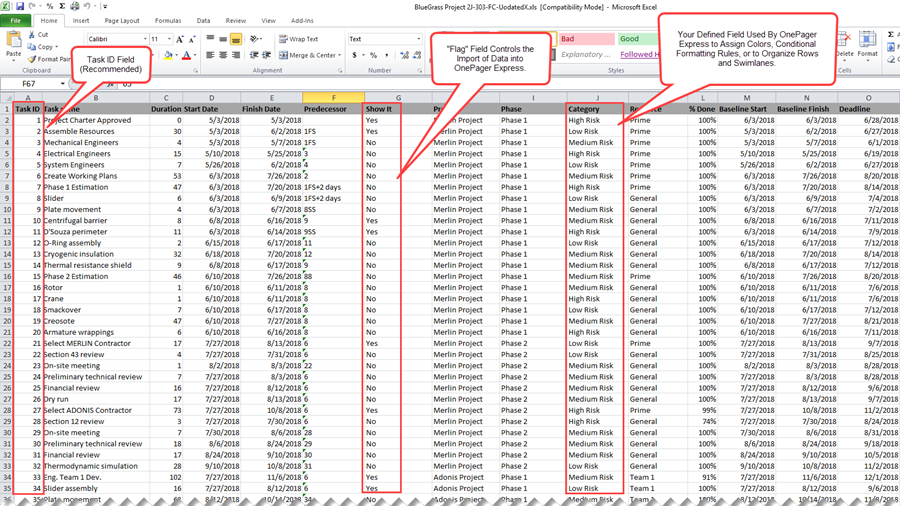
4) To control which tasks get graphed, you must specify a flag field (e.g. Show It) that you wish to use. Numeric fields can also be used the same as the text fields where a 1 in a Number field indicates Yes and a 0 in a Number field indicates No. See how this is done in the illustration above.
- a) When making your first project view, we strongly recommend that you mark 50 or fewer tasks with Yes.
- b) Please note that OPX is shipped with a number of fully populated Templates that are based on the Microsoft Excel file used in the tutorial also shipped with the product – BlueGrass Project 2J-303.
5) The following table describes field-heading types that OPX uses and shows variations on the heading titles that OnePager recognizes.
- a) It is not mandatory that you used these field names, since OPX gives you a chance to choose the actual Microsoft Excel source plan fields that it employs. However, using these names speeds things up because it helps OPX make reasonable guesses on which fields to use as its default selections.
- b) Note that it shows that three of the field heading types must always be present: Name, Start, and Finish.
- c) We recommend the inclusion of an ID field with sequential numbering from top to bottom. This assists OnePager maintain a correspondence with Microsoft Excel’s rows after the Microsoft Excel source plan is updated.
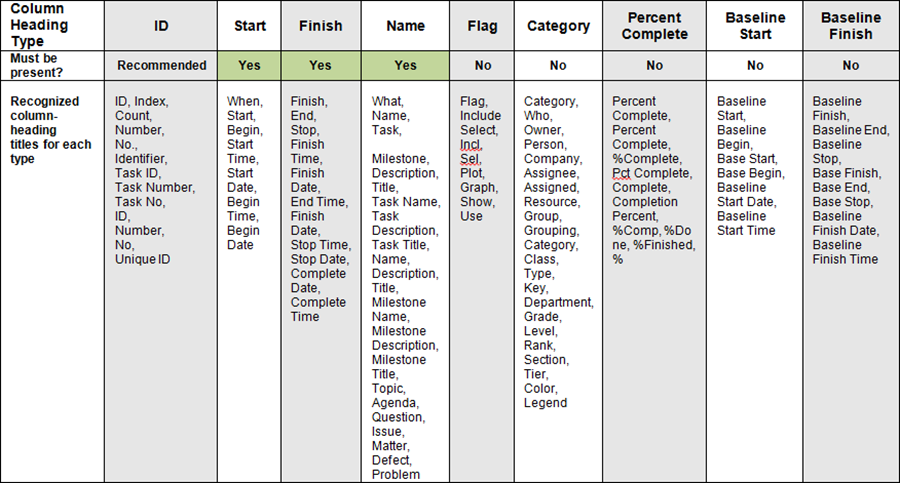
6) To launch OPX and make a project view, click on the OnePager Express... button on the Microsoft Express tool bar’s Add-ins tab, which brings up the OnePager Express Start form:
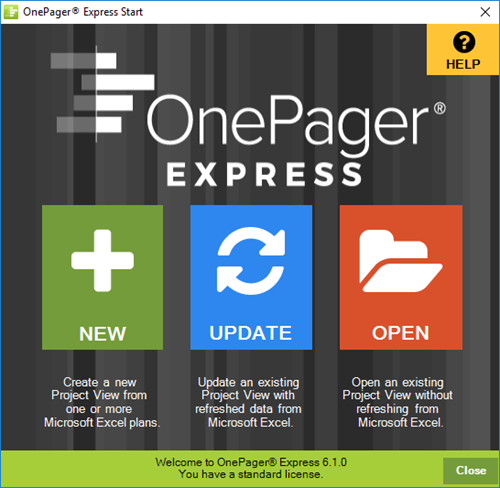
7) The OnePager Express Start form provides you with three options:
- a) NEW Clicking the NEW button brings up the OnePager choices (OPC) form.
- b) UPDATE Clicking the UPDATE button allows you to BROWSE FILES for an existing project view or select a recently-opened project view.
- c) OPEN Clicking the OPEN button allows you to BROWSE FILES for an existing project view or select a recently-opened project view. Once selected and opened, the project view is available for editing.
Creating a New Project View
1) Clicking the NEW button brings up the OPC form as shown below:
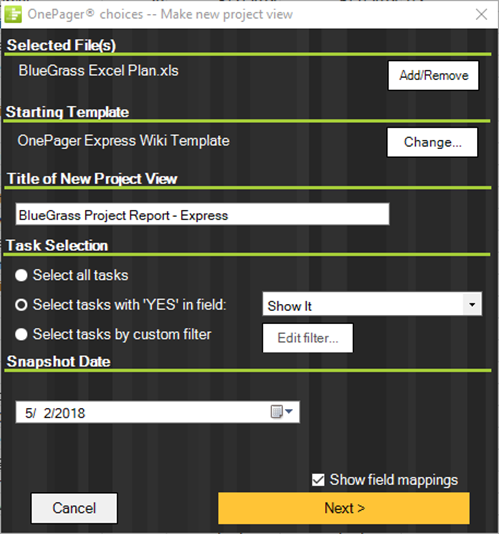
Options on the New OnePager Choices form
2) We’ve enhanced the OPC form to give you more options for selecting source files. The illustration above shows that OPX was initiated from Microsoft Excel with the source plan shown in the Selected File(s) group shown above. The Add/Remove button gives you the capability to add more source plans to the source packet or, for multiple file packets, to remove files.
- a) Clicking the Add/Remove button brings up the Data source selection form as shown below:
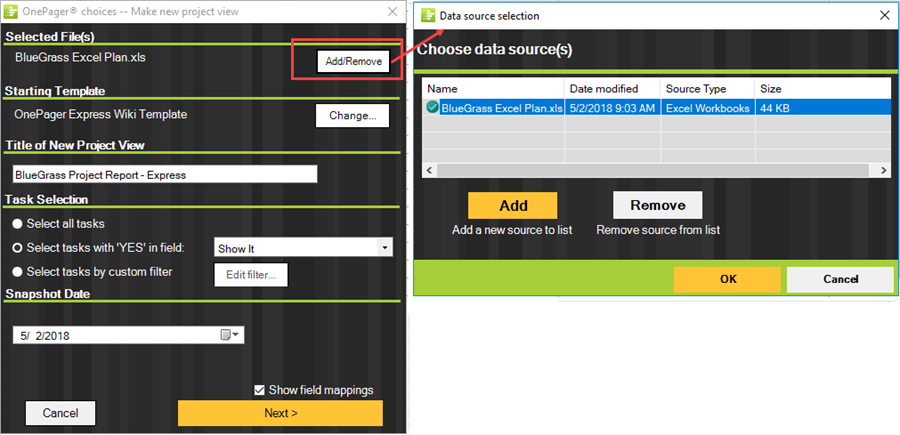
- b) The Data source selection form displays the current source plan that was loaded with Microsoft Excel when you clicked the OnePager Express... button. This form lets you Add more source Microsoft Excel source plans to create a multi-project project view or Remove a source plan from a multi-file source packet. These options are detailed below.
Adding a New Source Plan
- c) Add a new source plan to the source packet When you click the Add button, OPX gives you the option to bring up a Windows Open form when you select the BROWSE FILES… option as shown here:
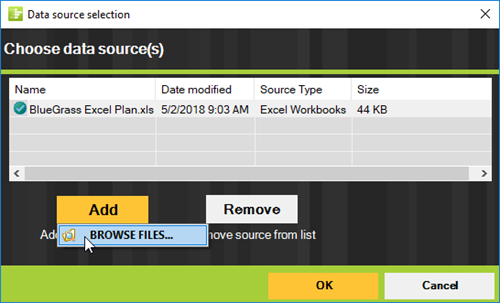
- i) Clicking the BROWSE FILES… option displays a Window’s Open from which you can select a Microsoft Excel source plan to add to the source packet. A sample Open form is shown below:
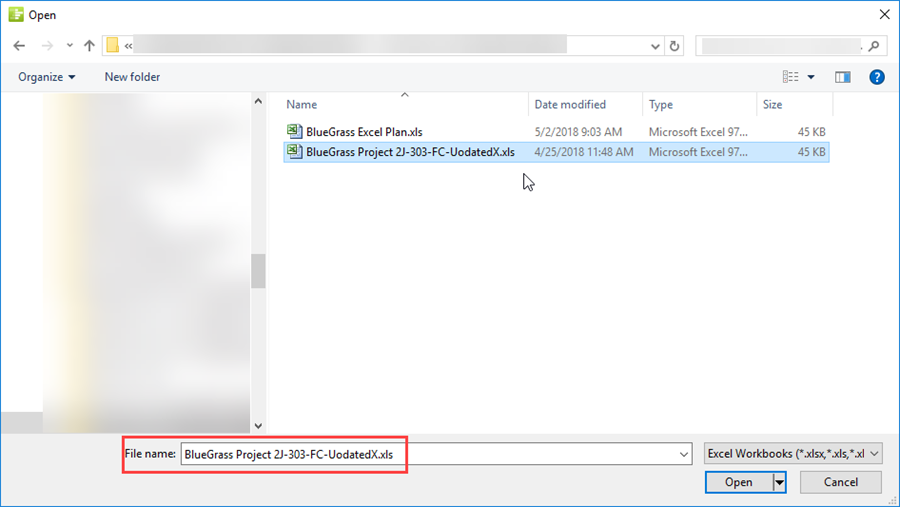
- ii) When you select a desired Microsoft Excel source plan and click the Open button as shown above, OPX adds the source plan to the source packet and displays it in the Data source selection window as shown below:
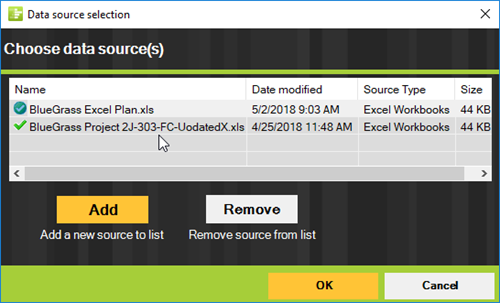
- iii) The selected source plan is added to the source packet as shown above. OPX shows the path name of the source plan in the window if you hover the mouse over the source plan name.
- iv) If you select a recently used source plan from the dropdown menu displayed with the Add button is clicked in the Data source selection form, OPX adds that source plan to the source packet.
Removing a Source Plan
- d) Remove source from source packet The Remove button allows you to remove a source plan from a source packet. if that source plan is not needed to create the new project view. To remove a file, first select the file in the Data source selection form’s window so that it is highlighted in blue then click the Remove button as shown in the sequence below:
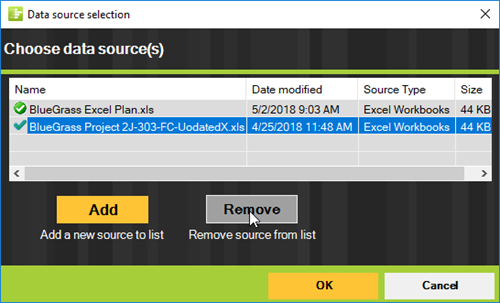
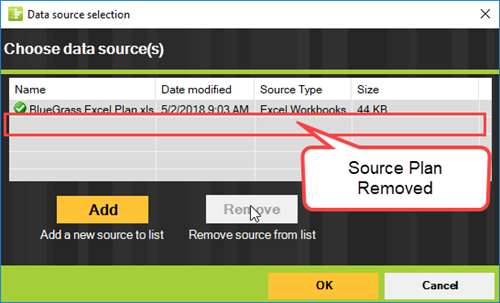
Other Choices to Make
3) Moving on to the other groups of the OPC form, you are asked to confirm a few things before you build the project view. It makes good guesses for each of these choices, but you can change any of them:
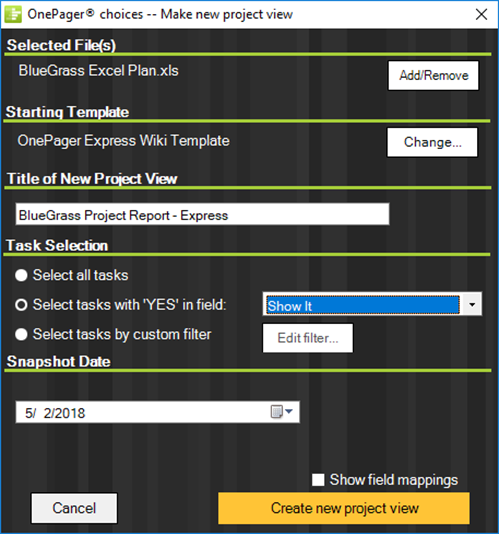
- a) Starting Template: The current Template determines which columns get imported from Microsoft Excel and how the initial project view looks. OPX ships with many sample Templates, but you can also customize your own Templates.
- i) To choose which Template to use in building your project view, click the Change… button in the top group of the OPC form.
- ii) For now, just stick with the default Template entitled Single Project Gantt View – Detailed, but you can always use a different Template to get a different type of project view.
- b) Title of the New Project View: This is the Title of the graph and also the suggested source plan name in which it is saved. You can change the source plan name when you save it. We recommend that you enter a Title that helps you identify the view later on.
- i) For each project view that you create, OnePager remembers colors, titles, legends, font sizes, and all other graph properties so that your work is saved for future use.
- ii) Later, you can update the project view with a snapshot of how the project looks on a different date. Then you can browse through the snapshots to see how the project is changing over time.
- iii) OPX also saves the path name associated with the source plan (.TAM). Path names are not available in .TAMs produced with version of OPX prior to version 6.0.
- c) Task Selection: This is how you tell OPX which tasks from your Microsoft Excel source plan to include.
- i) Either click the Select all tasks radio button to graph everything or choose a flag field. You can make several project views from a single Microsoft Excel source plan, each using a different flag or number field. In OPX if no flags are set to Yes, OPX provides the user with a warning message.
- ii) Clicking the Select tasks by custom filter button activates the Edit filters... button. Clicking the Edit filters... button takes you to a form that controls the new Conditional Import Filters feature. Please see the article titled Conditional Import Filters (Portal) for more detailed on the use of this new feature.
- d) Snapshot Date: This is the date of the report and lets you keep track of how schedules change over time. Each project view can have many snapshots.
4) The Show field mappings checkbox near the bottom of the form can be checked in the OPC form and gives a chance to review and change the Microsoft Excel field mappings to OPX before you make your first project view. To do this, click the Next> button. You see the following screen:
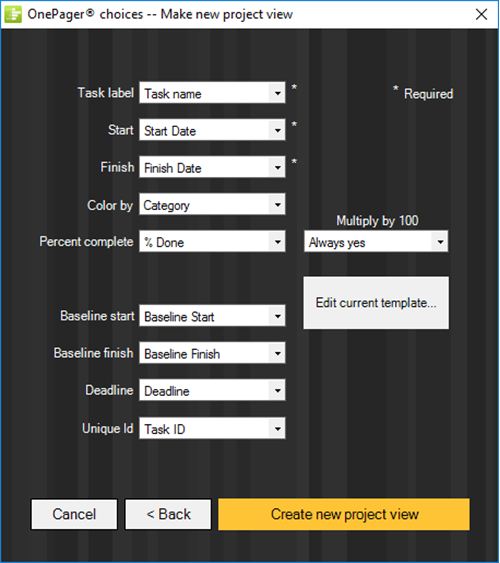
5) Notice in the graphic above that OPX has relied on the current Template to make some guesses on what Microsoft Excel fields should be used in making the graph. You can easily change any of these field mappings by making selections from the dropdown menus. For example, we show below how to change the Finish Date:
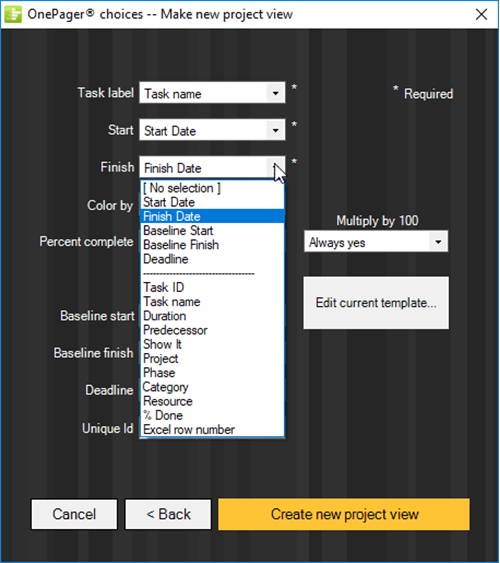
Making the Graph
6) Once you are satisfied with the field mappings, click on Create new project view button to import your selected data and create a project view. After a few second you see a screen that looks like this:
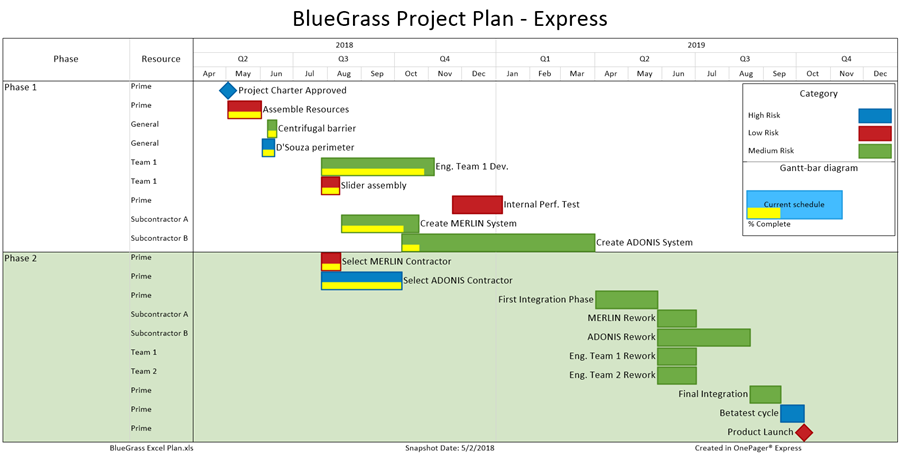
7) Note that each task or milestone was color coded based on the value in the Category field.
- a) The Legend contains an optional diagram near the bottom, explaining that the bars inside the Gantt bars represent percent complete extracted from Microsoft Excel.
- b) Percent complete comes from a Microsoft Excel field that you specified in the field mapping screen.
- c) Note that the current Template, when you press the Create new project view button, is the Template for how things look in the new project view. The Template form’s Task Bars tab showing where the color control is located is shown below:
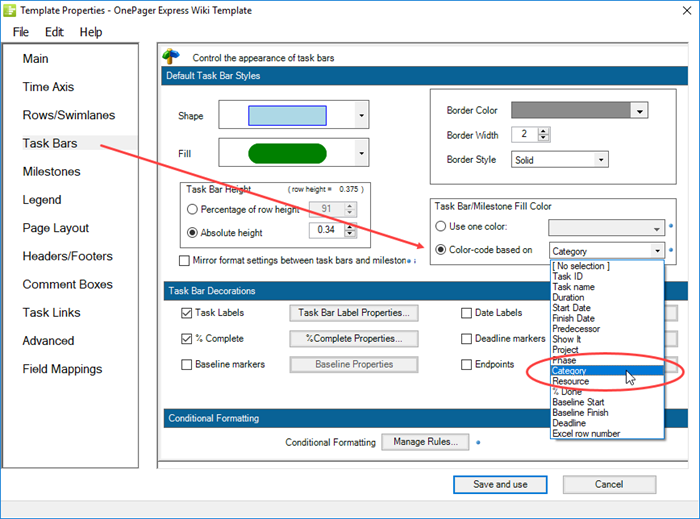
Opening a Project View
8) The right-most button on the OPC form is the OPEN button. Clicking the OPEN button displays a dropdown menu which happens to be the same for the NEW and UPDATE buttons. The options in the dropdown are discussed below:
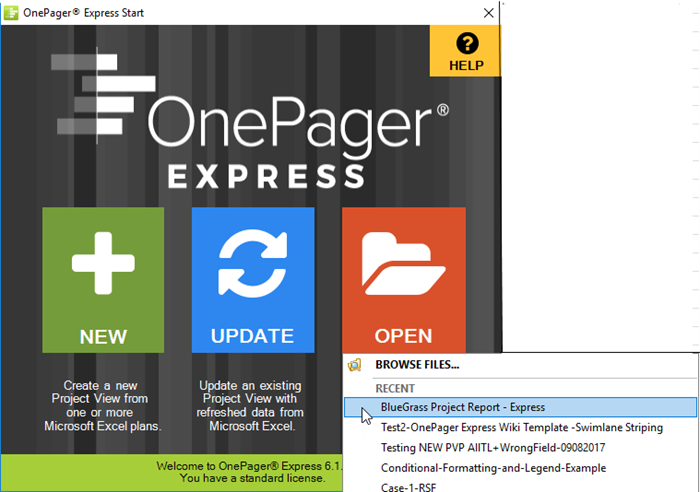
- a) Clicking the BROWSE FILES... option brings up a Windows Open form from which you can select a .TAM that you want to open. Selecting the desired .TAM causes OPX to display the selected project view. From this position, you can edit the project view, save it, or share it with others.
- b) Clicking any of the RECENT project view items the dropdown menu above causes OPX to load the associated .TAM into the PVE where you can edit the project view, save it, or share it with others.
Updating a Project View with Changes Made to the Microsoft Excel Source Plan Data
9) Suppose after examining the project view you created before you realize that it is best to show more task bars. This, you think, greatly improve the schedule discussion you are about to present Updating the project view at this point is a simple matter. Recall that OPX is active and the PVE is displaying the current project view you want to update. Additionally, the Microsoft Excel source plan and the application are active. The original project view looked like this:
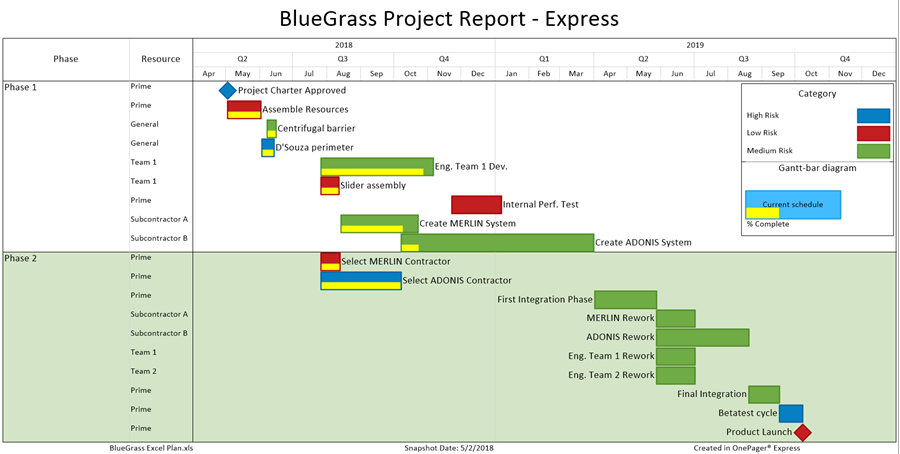
- a) Since Microsoft Excel is still an active program and the Microsoft Excel source plan you are using is still being displayed, go back to the Microsoft Excel application and change the Show It field setting for the rows you want to now display from No to Yes. As section of the Microsoft Excel source plan where this is done is shown below:
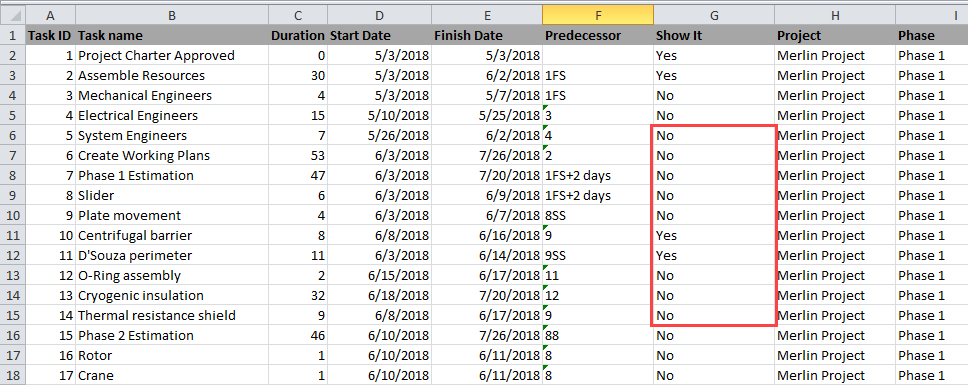
- b) Once you’ve made the Show It field changes lines 7 through 15 in the Microsoft Excel the source plan looks like this:

- c) With the Microsoft Excel source plan updated, go back to OPX and navigate to the Data tab on the ribbon where there are several buttons. To update your project view to now show the additional rows from your Microsoft Excel source plan click the Replace Snapshot button as shown below:
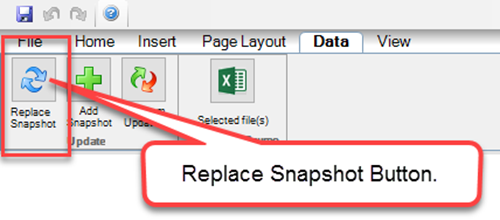
- d) When you click the Replace Snapshot button, OPX goes back to the associated Microsoft Excel source plan that you just changed, bring in all the rows that changed, and update your project view.
- e) At the conclusion of the operation, the updated project view looks like this:
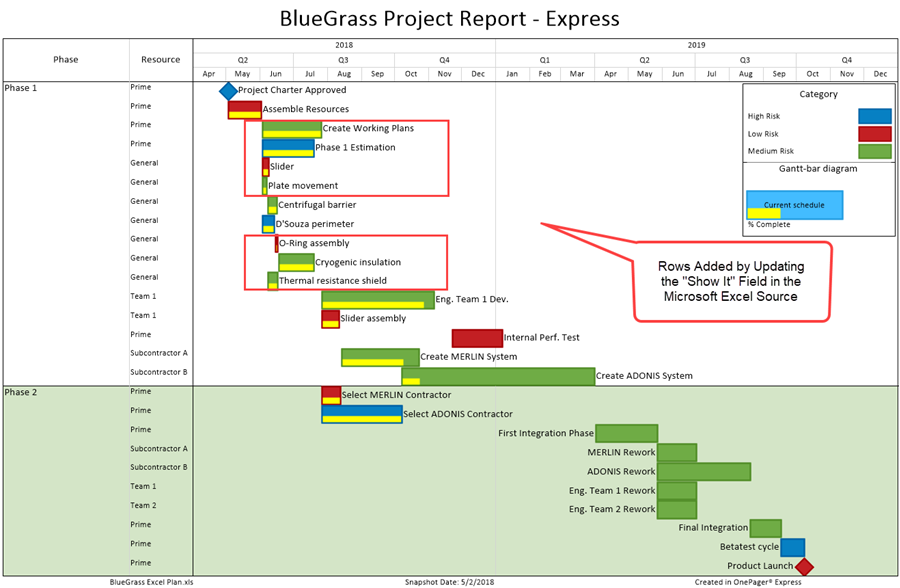
10) The example above is just one of many uses of the Data tab’s Replace Snapshot button when you need to update a project view. And, you can do this as many times as necessary until the project view is the way you need it. In addition to adding and removing rows by changing the Show It field, you can change Start Dates, Finish Dates, or Resource Names' and display these data changes in the project view. Using the procedure above you can do this very efficiently.
11) You can now save the project view by giving it a name. When you save the project view in OPX, OnePager saves the .TAM and saves the Microsoft Excel source plan name and path information. This is useful when you want to further update the project view or when you want to add a snapshot later on. In the examples below it is assumes that the project view is saved as BlueGrass Project Report - Express.
Adding a Snapshot to a Project View
12) The power of OPX is illustrated when, after a period of progress on the project, it is time to produce another project view. OnePager produces your next snapshot with the same look and feel as the original. Assuming that the Microsoft Excel source plan was updated with actual start and finish, percent complete, and other relevant data during the reporting interval, OPX can easily generate a new snapshot.
13) Suppose we have the following project view created on 11/1/2018 and we want to create another graph from the updated Microsoft Project source plan on 12/1/2018.
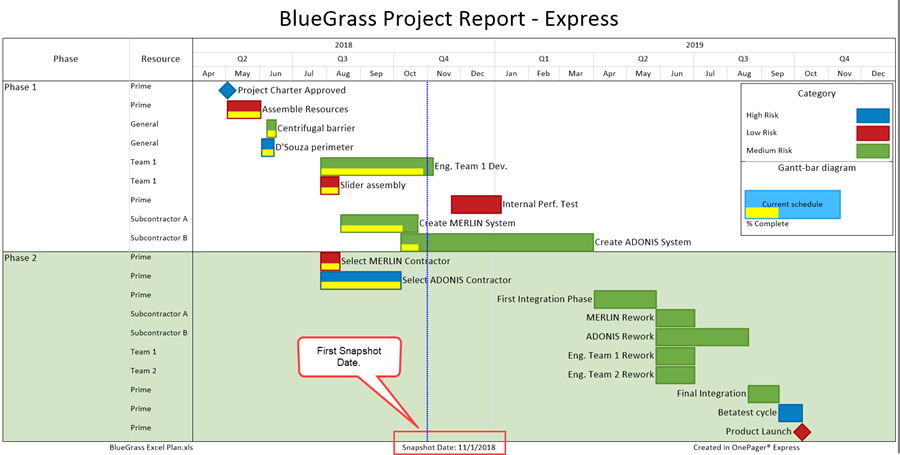
- a) Before creating a new snapshot for 12/1/2018 as planned, we need to update the Microsoft Excel source plan say by updating the Percent Complete for the following tasks to the percentage indicated:
- i) Eng. Team 1 Dev. - 100%
- ii) Internal Perf. Test - 10%
- iii) Create MERLIN System - 100%
- iv) Create ADONIS System - 25%
- b) When the source plan is updated with this revised information we can proceed.
- c) Launch OPX either from Microsoft Excel or from the Desktop icon and click the UPDATE button on the OnePager Express Start form. Doing so brings up the following OnePager choices (OPC) form:
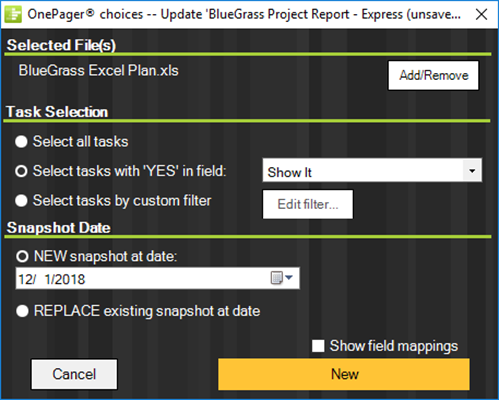
- d) In the OPC form above we selected the NEW snapshot at date: as shown. You can want to select a current date for the snapshot so that this snapshot represents the project at the status date point in time. To see which snapshot dates already exist, just position your mouse over the NEW snapshot-date: window to see a list of the existing dates.
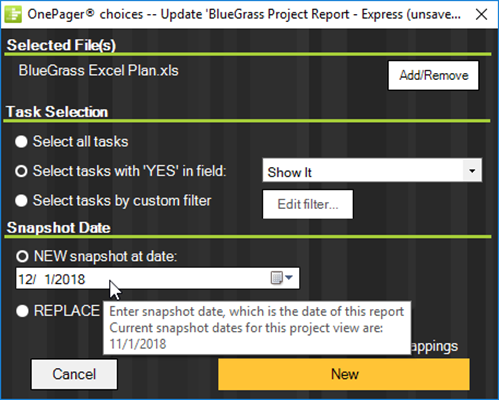
- e) Use the built in calendar dropdown or type in the new snapshot’s month, day, and year in the window provided as shown below:
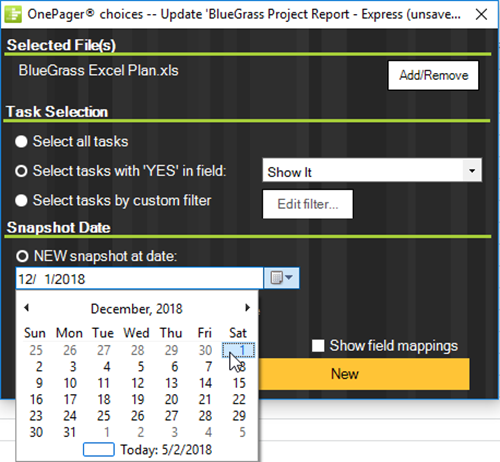
- f) Uncheck the Show field mappings checkbox if you want to use the same field mappings as you used before. The bottom of the screen now looks like this:

- g) Pressing the large New button creates a new snapshot for the project view. The project view opens at the new snapshot. The color, fonts, title, and swimlane assignments are consistent between the two snapshots:
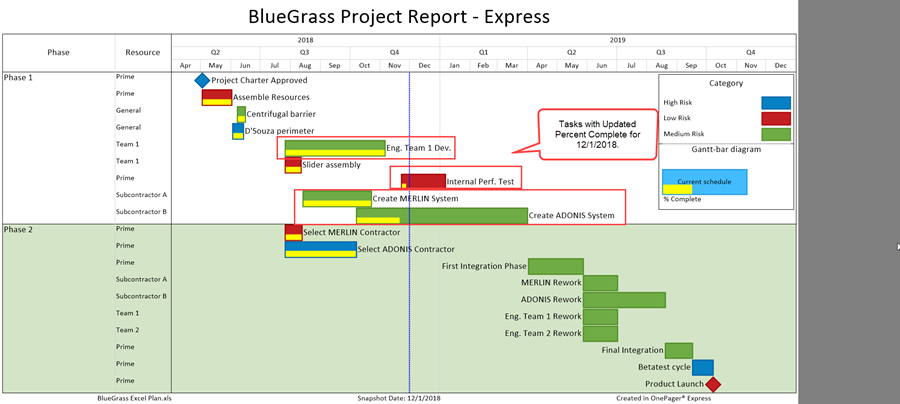
- h) You can go back and forth between the two snapshots by using the snapshot forward/backward buttons on the View tab as shown below:
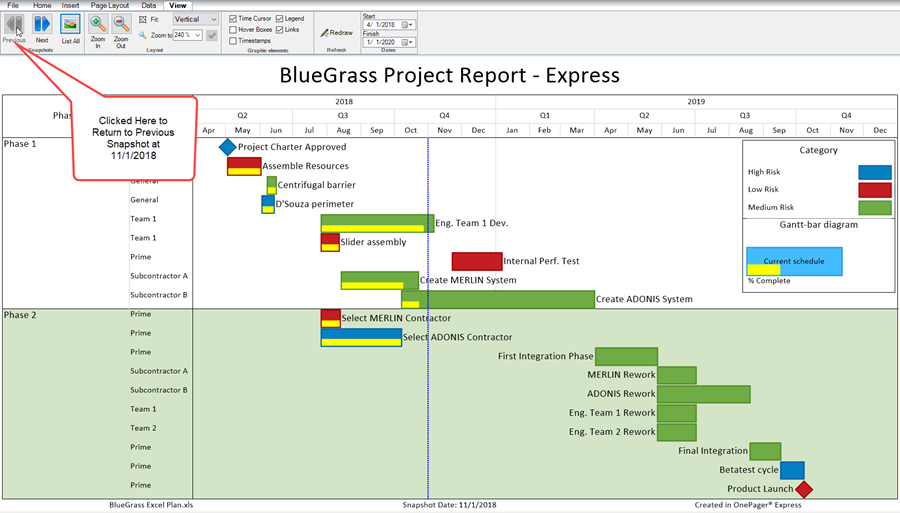
Editing the Project View
1) You can edit the font sizes and text positions to optimize readability. To do this, hold down the left mouse button and drag a selection box that encloses many tasks/milestones at once (Lasso):
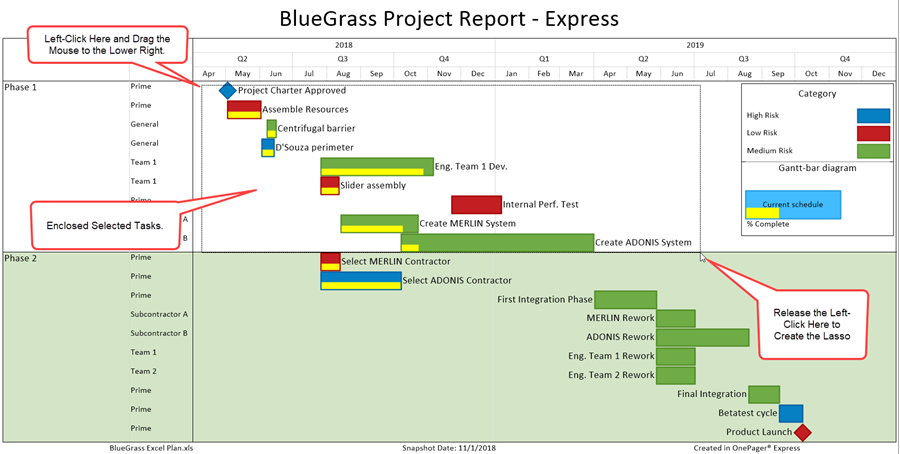
- a) When you release the mouse, the enclosed tasks/milestones are all be selected:
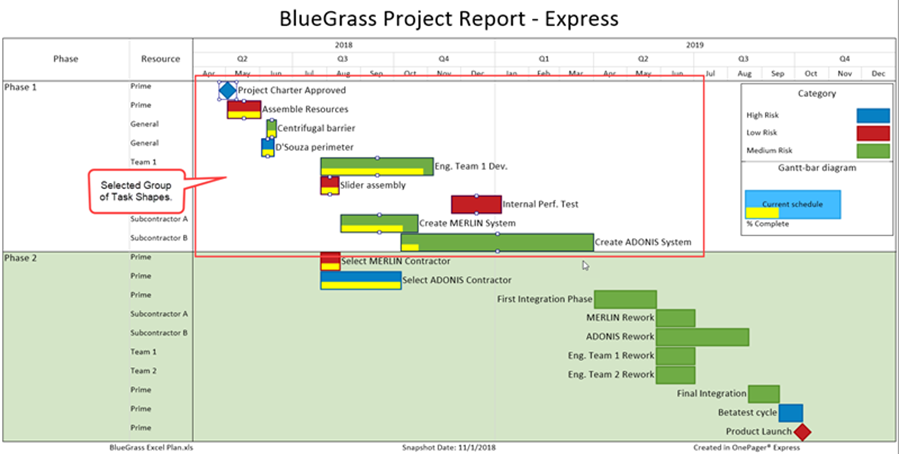
- b) Click on the Increase Font Size button on the tool bar shown below:

- c) The project view now looks something like this:
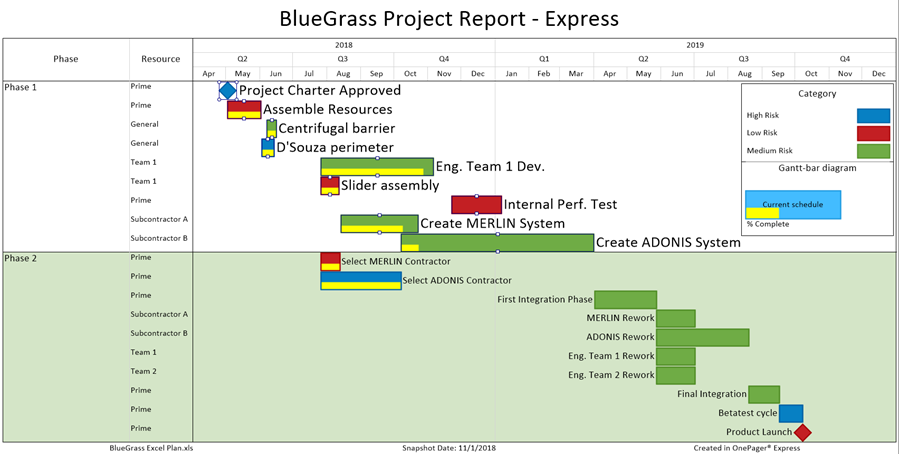
- d) Repeating this operation for the remaining tasks/milestones (we could have done Select All and done it all at once!), we obtain a project view with larger fonts on all the tasks/milestones:
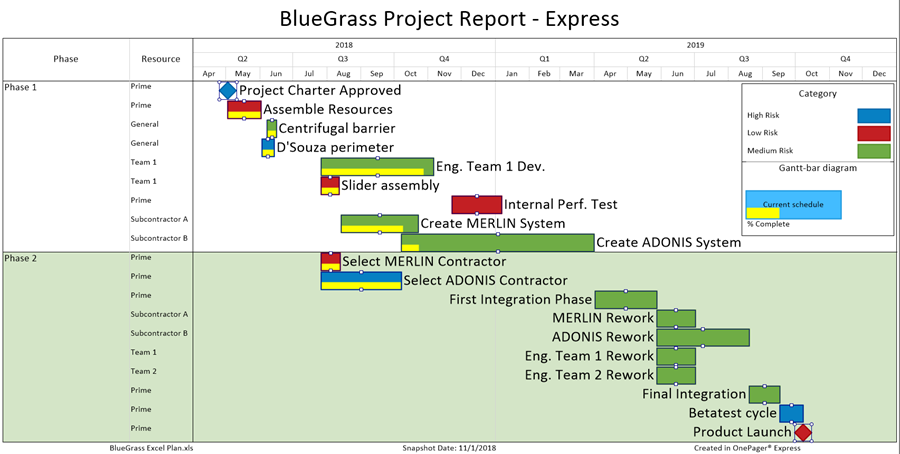
2) Another common editing action is to move the task names from their current positions to a positions elsewhere around or on the task bar.
- a) To do this, select a set of tasks/milestones as before, but this time click one of the text-positioning buttons on the tool bar:
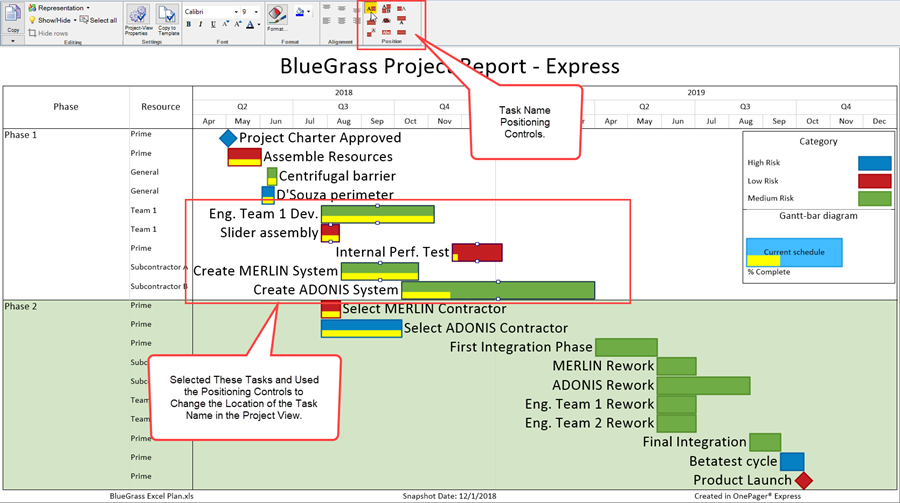
- b) In case you change your mind about the last editing action you took, you can UNDO the last editing action by clicking the UNDO button above the OnePager tool bar. Successive clicking the UNDO button undoes editing actions in the reverse order that they were applied.
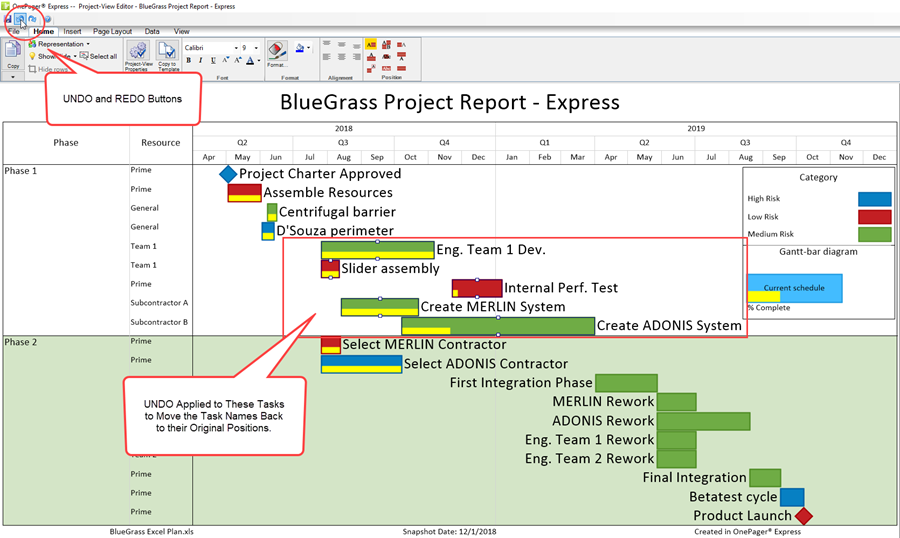
3) Save the edited project view by clicking the Save button above the tool bar next to the UNDO button. All of the font size changes, text-position edits, and the new Legend position are now saved in the file structure in case you need to update this project view with new data at a later time.
Copying the Project View to PowerPoint
4) Finally copy the current snapshot of the project view to the clipboard by clicking the Copy button on the Home ribbon. Then paste the graph into a PowerPoint slide, as shown below:
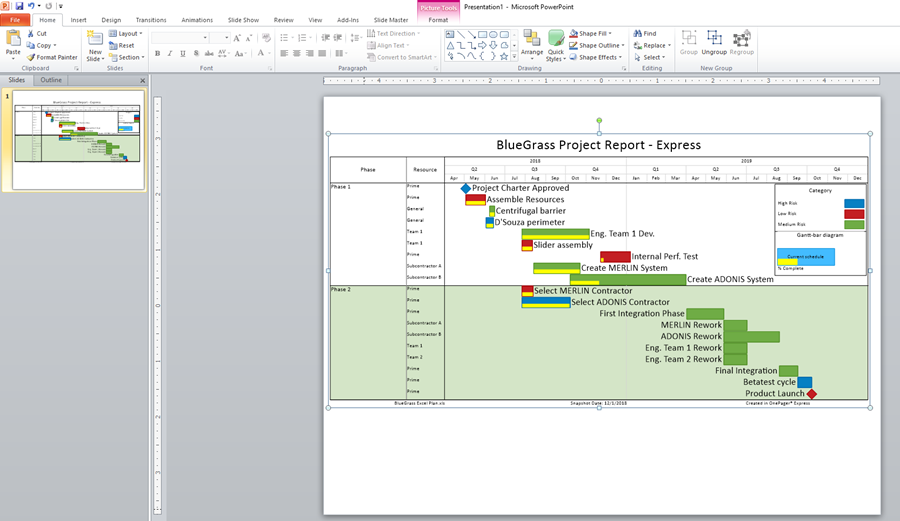
5) That’s it! You have now created a professional 1-page schedule summary from a complex Microsoft Excel schedule and have copied it into a PowerPoint presentation.
- a) You can also print the graph by selecting the Print button on the File tab.
- b) OnePager has other features that let you move tasks vertically to different rows and swimlanes, change the number of swimlanes, add swimlane titles, show dependencies among tasks, change task colors, hide tasks, add floating comment boxes, and standardize on graph styles across organizations.
- c) To learn more about these features, read about the specific workflows in this Wiki at Basic Workflows (Portal) and Manual versus Data-Driven Editing (Portal).
Displaying Data-Driven Task Links
6) OnePager Express 6.1 is enhanced to assist you with displaying Task Link dependencies from data you provide in your Microsoft Excel source plan. Typically, this feature is turned OFF in all Templates distributed with OnePager. However, the feature can be turned ON either before or after the creation of a project view.
- a) To turn the Data-Driven Task Link feature ON prior to creating a project view, go to the Template form you plan to uses and click on the Task Links tab and then click the Import predecessors checkbox in the Data-Driven Task Links control group as shown below:
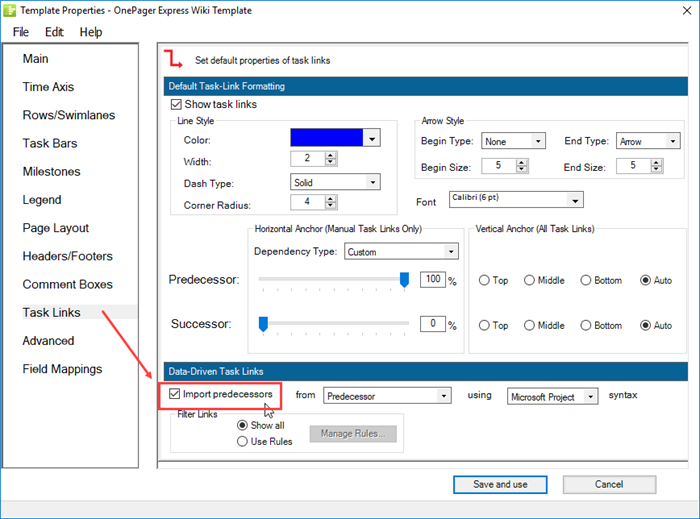
- b) In the Template Task Link tab above there are two additional controls that need to be set to tell OnePager Express which data field you are using to express task dependencies in the form of predecessors and which dependency format you are using either (1) Microsoft Project or (2) Oracle Primavera. These controls are in the form of dropdown menus as shown for the dependency format selector below:
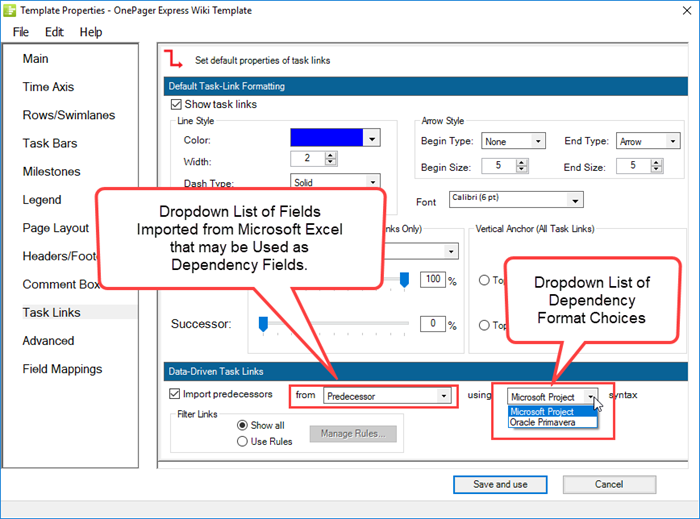
- c) With the Import predecessors checkbox checked and the dependency data field and dependency format selections made in the Template form, the project view first created looks like this:
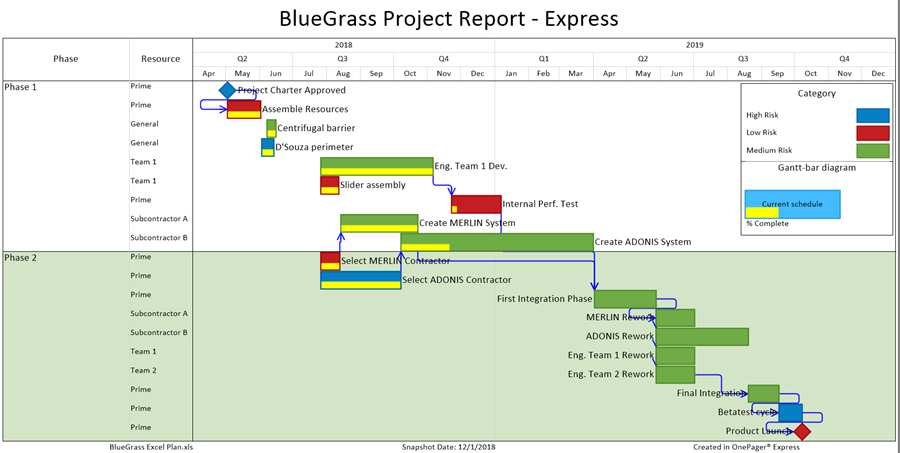
- d) To turn the Data-Driven Task Link feature ON after the project view is created, go to the Project-View Properties form's Task Links tab and then click the Import predecessors checkbox in the Data-Driven Task Links control group as shown below:
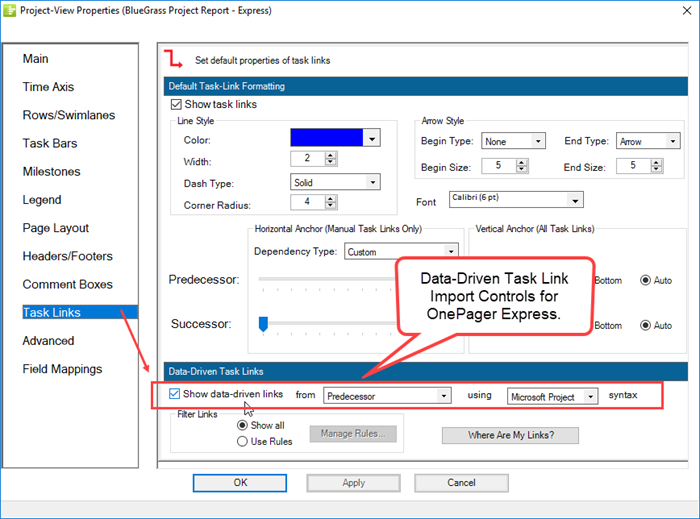
- e) Once imported, Data-Driven Task Links can be shown or hidden and can be edited globally using the Template/Project-View Properties forms as shown above or individually using a selection right-click context menu.
- f) OnePager Express 6.1 continues to support manual Task Links which in previous OnePager Express versions were called Event Links.
7) The OnePager version 6.1 Data-Driven Task Links feature is flexible and powerful. More details are provided in the series of articles at: Linking Task and Milestone Using Manual and Data-Driven Task Links (Portal).
Related Links
What's New with OnePager Release 6.1?
Getting Started with OnePager Express Desktop
Conditional Import Filters (Portal)
Manual versus Data-Driven Editing (Portal)
Linking Task and Milestone Using Manual and Data-Driven Task Links (Portal)
(3.0.2.1-61)